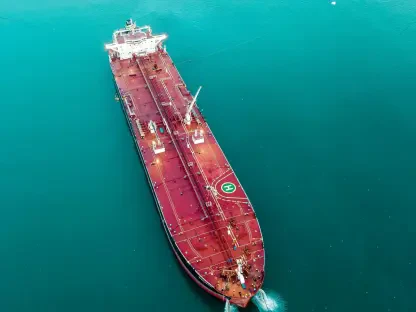In an era where environmental challenges are intensifying, the impact of climate risk on corporate value chains has emerged as a pressing concern for businesses worldwide, with recent reports indicating that natural disasters and shifting weather patterns are no longer distant threats but active disruptors of global trade and economic stability. Companies that fail to account for these risks face cascading effects that can cripple operations, from halted production to broken supply lines. A striking example is the devastating floods in regions like Brazil, where critical infrastructure damage has delayed exports of essential goods, sending shockwaves through international markets. This scenario highlights a broader reality: climate events are not isolated incidents but interconnected challenges that threaten the entire spectrum of activities a company undertakes to create and deliver products. As these disruptions grow in frequency and severity, understanding their influence on corporate systems becomes not just a strategic advantage but a necessity for survival in a volatile world.
Unveiling the Hidden Threats in Supply Networks
The concept of a value chain encompasses every step a company takes to bring a product or service to market, from sourcing raw materials to delivering the final offering to consumers. Climate risk infiltrates this intricate web far beyond a company’s immediate control, impacting suppliers, logistics, and even customer demand. Consider the ripple effects of a single event, such as a major storm disrupting a key transportation hub. This can lead to delays in raw material shipments, stall manufacturing processes, and ultimately result in empty shelves for retailers. Such incidents reveal how interconnected global networks are vulnerable to localized climate impacts. The economic fallout is often staggering, with shortages driving up costs and creating inflationary pressures that affect industries worldwide. Businesses that overlook these vulnerabilities risk not only operational setbacks but also significant financial losses as they scramble to address unforeseen bottlenecks in their supply chains.
Moreover, the financial implications of ignoring climate risks are becoming increasingly evident as the frequency of natural disasters rises. According to recent estimates, global economic losses from such events reached a staggering $320 billion in a single year, a figure that far exceeds historical averages even when adjusted for inflation. Projections suggest that if global temperatures increase beyond 3.6 degrees Fahrenheit (2 degrees Celsius), the world could face a 4.4% loss in GDP by 2050. This long-term outlook underscores the urgency for companies to integrate climate considerations into their strategic planning. Failing to do so jeopardizes not just individual enterprises but the stability of entire markets. The potential for widespread shortages of essential goods looms large, threatening to diminish quality of life on a global scale. As these risks compound, the need for a proactive approach to safeguarding value chains against environmental disruptions becomes a critical priority for corporate leaders across sectors.
Corporate Preparedness: A Gap in Resilience
Despite the mounting evidence of climate-driven disruptions, many companies remain unprepared to tackle these challenges head-on. Current data reveals a troubling statistic: only about 20% of businesses have developed adaptation plans to address climate risks within their operations. Even among those with plans, less than half intend to implement them within the next decade, leaving a significant portion of the corporate world exposed to potential crises. This lack of urgency is particularly concerning given the diverse nature of risks, which vary based on geographic location and the specific vulnerabilities of a company’s assets. Whether it’s extreme heat affecting production facilities or flooding disrupting transportation routes, the impacts are often unpredictable and severe. Without robust strategies in place, businesses risk being caught off guard by events that could have been mitigated through foresight and planning.
On a more hopeful note, there is a growing recognition among forward-thinking companies that investing in adaptation can yield significant benefits. Tailored strategies that account for specific hazards—such as drought, storms, or rising sea levels—can help mitigate risks and ensure operational continuity. For instance, sectors with high exposure, like agriculture and manufacturing, are beginning to explore innovative solutions to protect their supply chains from climate shocks. These efforts not only safeguard profitability but also build trust with consumers who increasingly value sustainability. By prioritizing resilience, companies can position themselves to respond effectively to disruptions, minimizing downtime and maintaining market competitiveness. While adoption of such measures remains slow across the board, the potential for positive change exists, provided corporate leaders commit to embedding climate risk assessment into their long-term vision and decision-making processes.
Pathways to a More Stable Future
Reflecting on the challenges posed by climate risks, it has become clear that businesses have often underestimated the far-reaching consequences of environmental disruptions on their value chains. The economic toll of natural disasters has mounted, with billions in losses recorded annually, exposing the fragility of global supply networks. Real-world events, such as floods devastating critical infrastructure, have demonstrated how localized incidents can trigger widespread shortages and logistical nightmares. Many companies have lagged in their preparedness, with only a small fraction taking actionable steps to adapt to these growing threats. Yet, amidst these sobering realities, a critical lesson has emerged: strategic planning and investment in resilience have proven to be viable defenses against operational collapse. Looking ahead, the focus must shift to integrating climate risk into every facet of corporate strategy. By collaborating with stakeholders, leveraging data-driven insights, and adopting innovative technologies, businesses can build robust systems capable of withstanding environmental challenges, ensuring not only their survival but also contributing to a more resilient global economy.









